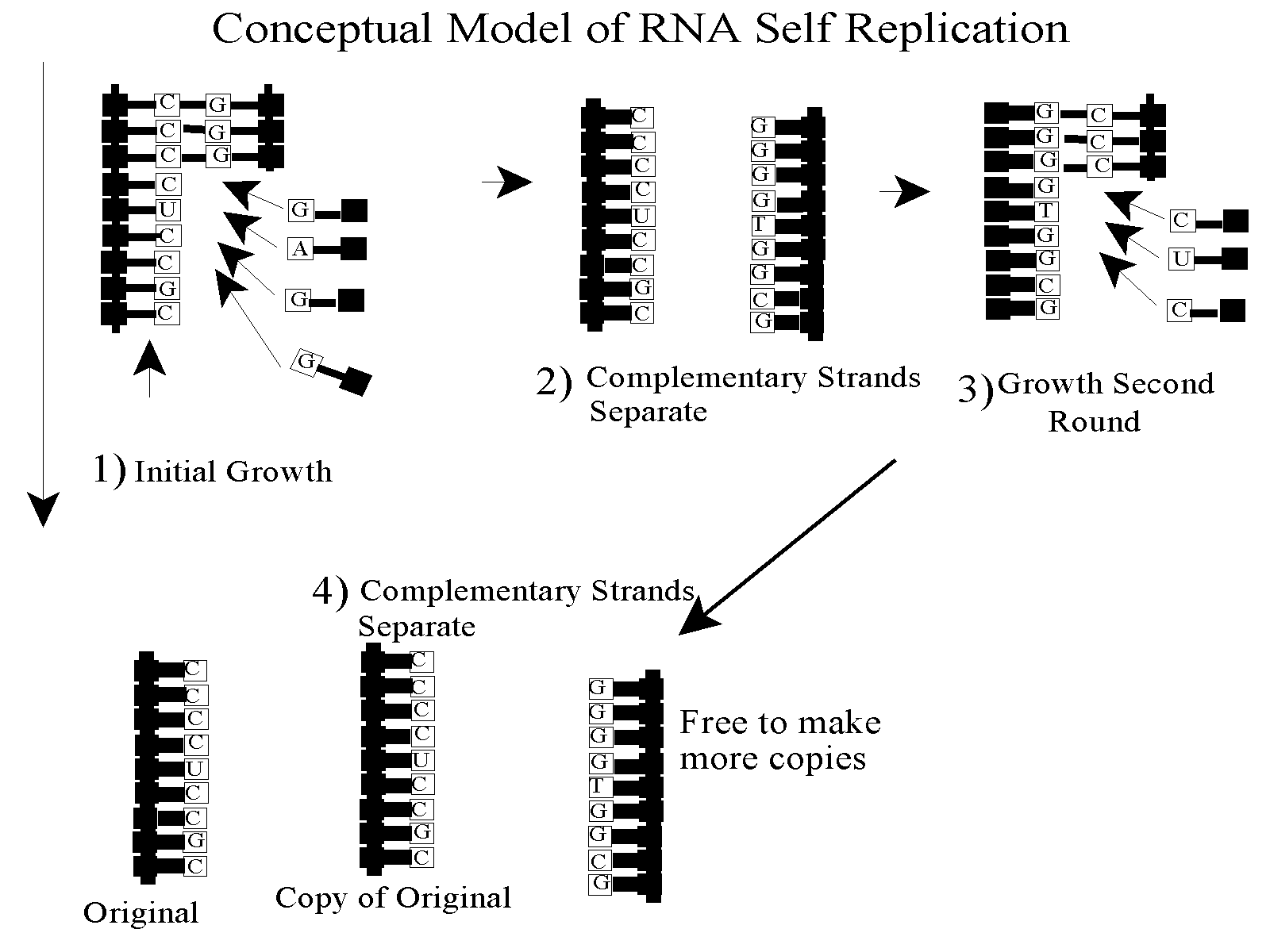
7. Rna Self Replication
Conceptually RNA should be able to self replicate without the help of proteins.. The original strand serves as a template. New base pairs arrive and form weak bonds with their complement. Adenine can form a bond with Uracil, and Guanine can form a bond with Cytosine. After one replication, two complementary strands exist. Another round of replication is necessary to duplicate the original strand. The complement to the original strand is also free to make more copies. While this is still the most promising theory for life's origin, this theory seems to offer more problems than solutions.

The problems were described by Joyce and Orgel as follows:
• Most strands of RNA are unsuitable templates. The original RNA molecule that serves as the template must contain a very high concentration of cytosine to make process 1 in figure viable.2,3 This situation is unlikely to be met because as discussed earlier cytosine has no plausible prebiotic synthesis pathway and it decays rapidly. Nevertheless, the original strand depicted in figure meets the high C requirement.
• The chain will not grow correctly unless a very specific activation agent is used to activate the nucleotides. The activation agent of choice is not ATP (GTP, CTP or UTP). While life uses these, if these activation agents are used without proteins the phosphate bonds usually attach to the wrong carbon atom in ribose. ImpA, impG, impU and impC are the activation agents of choice. These activation agents contain the same side group as the amino acid histidine, which is one of the three amino acids that have not been synthesized in prebiotic experiments. Thus, it is unlikely that these activation agents where present in the primordial soup.
• The complement of the original chain will have a high G content. This is inevitable due to the requirement for high C in the original chain. This is problematic because RNA with a high concentration of guanine tends to fold up in such a way that it cannot be an effective template for replication. Thus, the second round of growth in figure does not happen.
• If different isomers of ribose are present, these isomers will terminate the growing chain.
Joyce and Orgel comment that “In light of the available evidence, it seems unlikely that a pair of complementary sequences can be found each of which facilitates the synthesis of the other . . . ”
Just to add to the difficulties, if too many steps form in the replication ladder (complementary bonds between base pairs), then the strands will never separate. Furthermore, figure is oversimplified in that it does not show that in order for the RNA strands to grow, an RNA enzyme is required to catalyze the reaction. Because a growing chain cannot catalyze its own replication, two identical RNA molecules must arise simultaneously in the soup. Each capable of replicating the other.
A pattern is beginning to emerge for the RNA world. The RNA world is a speculative world without proteins where RNA is the most important molecule. RNA regulates all chemical reactions and contains all of the molecular knowledge for life. The pattern that is emerging is that perhaps this world is too speculative in that it may have never existed.
One last point, RNA replication in the lab makes use of extensive investigator interference. Chemicals like amino acids, aldehydes, and sugars (other than ribose) are arbitrarily excluded. Very specific activation agents are used to encourage replication (ImpA for adenine, ImpG for guanine, ImpC for cytosine, and ImpU for uracil). The concentration of the chemicals (especially cytosine and ribose) is billions and billions of orders of magnitude higher than what one would expect under plausible prebiotic conditions.
Dynamite is being used to blow the door open in figure 9.4, and the door is just too solid. It remains closed and the scientist remains trapped. Fortunately, many scientists understand this, and they no longer claim that the door is open.
